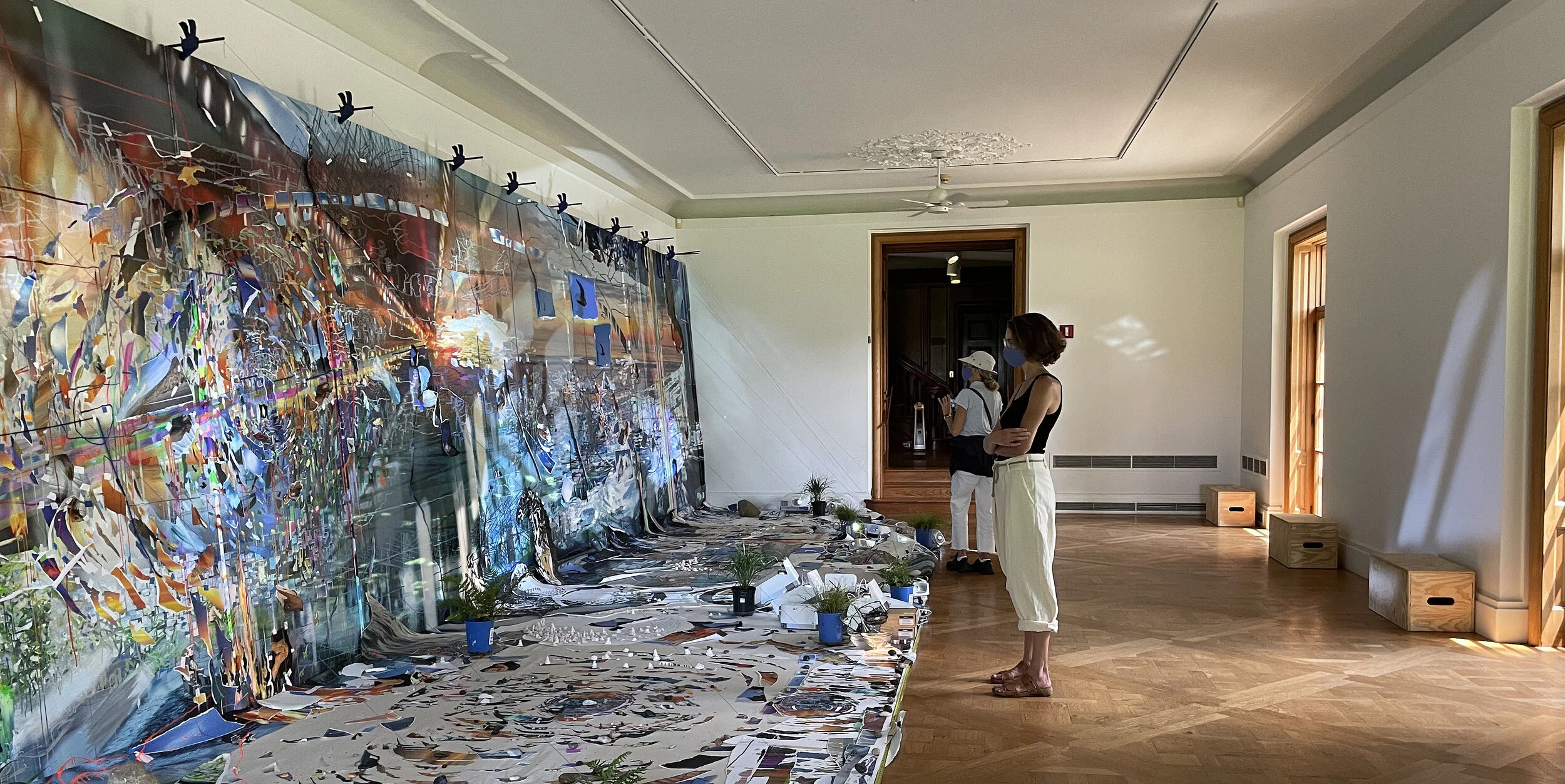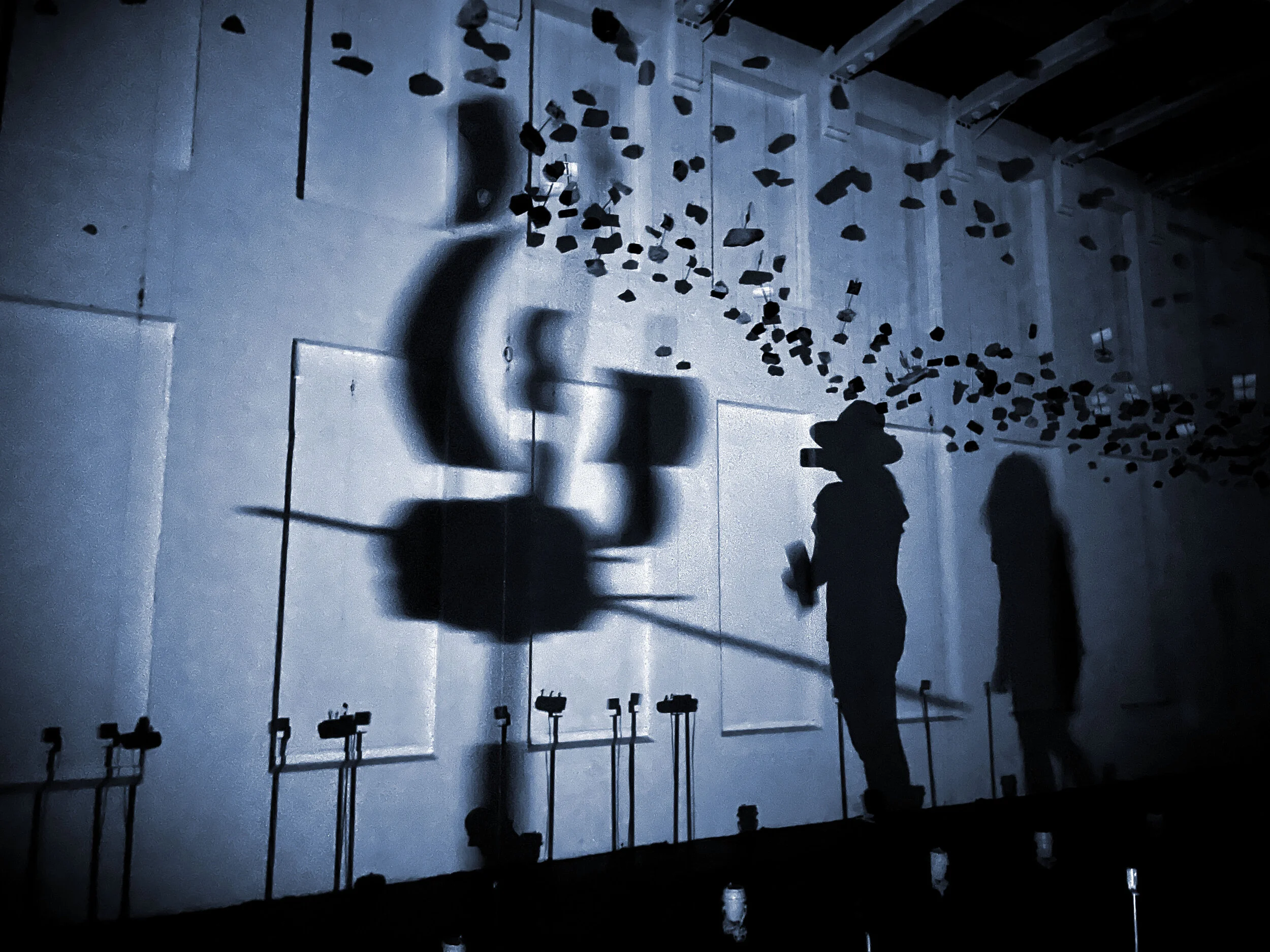Shattered Worlds
The theme of the broken world is a popular one this summer. Sarah Sze’s (b. 1969) and Glenn Kaino’s (b. 1972) delve into the post-apocalyptic visions of our present and near future. In the current political, environmental and epidemiological world it is hardly surprising that the theme of crisis resonates with the artists and their audiences.
Sarah Sze, Fifth Season, 2021, Photo by Irina Sheynfeld
Fifth Season (2021) is an immersive installation located in the Museum Building at Storm King Art Center, that Sze created to accompany her new permanent outdoor sculpture Fallen Sky (2021). Fifth Season represents the world in flux, broken into pieces, and permanently damaged. It is neither sculpture nor painting although it incorporates elements of both. The installation spans fifty feet in length and it merges the corporeal and the metaphysical, creating a colorful portal out of the broken bits leftover from our shattered world. One of the many themes of Sze’s work is our ever-changing relationship with the world of reproductions. In an interview with Art21 from 2016, Sze describes how in the past twenty years images simultaneously became ubiquitous and worthless, — “You don’t know the name of the author when the image gets to you. You can manipulate it. You can send it. It is a kind of images-as-debris.” (1)
Sarah Sze, Fifth Season, 2021, Photo by Irina Sheynfeld
Fifth Season consists of a myriad of small pieces, some manufactured some created by the artist. Projectors, fans, plastic bottles, glass bows, small stones, potted plants, reading lamps, shards of mirrors, and fragments of photographs are scattered on the fifty feet long cloth hanging from the top of the wall and spread out on the floor. The elements seem to be converging in a milky way fashion towards the center, creating new world order out of the broken pieces from the civilization that lost its way. The projectors shine the natural sunlight that was filmed in the same room but at different times of the day, heightening the effect of the artificiality. The tangle of wires echoes the zigzagging white and purple lines printed on multiple paper planes.
Even though Zhe’s work is emphasizing the fleeting quality of the human-made world and the worthlessness of the photographic image, Fifth Season looks much better photographed than in person. As a second-generation image, the work gains the beauty and completeness that the original lucks. The work is more interesting to write or read about than to see — its physical presence is less than the sum of its parts.
Sarah Sze, Fifth Season, 2021, Photo by Irina Sheynfeld
Unlike Sze’s work In the Light of a Shadow is worth the trip to the museum, since neither photos nor videos do justice to the multi-sensory experience of the work. In the Light fills the 20,000-square-foot space of Building 5 at Mass MoCA. The installation resembles the moment after an explosion when the dust and the debris didn’t yet have a chance to settle. Pieces of rocks, bricks, and cement are suspended in the air by thin wires. They seem to levitate as if frozen in time. If the viewer examines the scattered rocks closer they will see the tiny masts with found postcards attached to them as sails. Like torn pieces of photographs in Sze’s installation, Kaino’s postcards remind the viewer of the shards from a broken world. Pieces of memories, once treasured, but now worthless and discarded. Where do these rock-bottomed vessels under the sails of forgotten memories are destined to go?
Glenn Kaino, In the Light of a Shadow, 2021 (installation view) Photo by Irina Sheynfeld
The title of the work, In the Light of a Shadow, refers to a wooden fishing boat Shadow V, which was blown up by the Irish Republican Army on August 27, 1979, while it was carrying Lord Mountbatten and his grandchildren of the coast of Ireland. “The boat was there one minute and the next minute it was like a lot of matchsticks floating on the water,” a witness told the New York Times. (2) The reconstruction of the boat Shadow V, surrounded by shards of rocks and broken planks of wood converge in the spiral flux, forming a giant ouroboros: a mythical snake that eats its own tail. The work directly and metaphorically concerns itself with themes of colonization and struggle for liberation. The key part of In the Light of a Shadow are tiny models of boats that sail along the tiny tracks lit by projectors in almost complete darkness. The ships are small, fragile, and innocent as small toys but their shadows, moving with the sound along the walls, are enormous and menacing.
Glenn Kaino, In the Light of a Shadow, 2021 (installation view) Photo by Irina Sheynfeld
In the Light of the Shadow examines the intersections where struggles for freedom overlap. Two events in history now known as Bloody Sunday inspired Kaino: the March 7, 1965 clash between protesters and state troopers at Selma, Alabama, and January 30, 1972, civil rights march in Derry, Northern Ireland, when dozens of people were killed by the British military. The multi-dimensional soundscape is an important part of the experience and one of the central melodies is the U2’s 1983 song “Sunday Bloody Sunday.” In the interview with The New York Times reporter Ted Loos, Kaino said that “The thread is that the struggle for equality is universal.” (3)
Glenn Kaino, In the Light of a Shadow, 2021 (installation view) Photo by Irina Sheynfeld
Artnet News, “'We Have so MUCH Illusion': Watch ARTIST Sarah Sze Blend the Tactility of Organic Materials with the Intangibility of Images,” Artnet News (Artnet News, June 24, 2021), https://news.artnet.com/art-world/sarah-sze-art21-2-1983243.
Lesley Kennedy, “The IRA Assassination of Lord Mountbatten: Facts and Fallout,” History.com (A&E Television Networks, November 13, 2020), https://www.history.com/news/mountbatten-assassination-ira-thatcher.
Ted Loos, “At MassMoCA, Art and the Struggle for Equality,” The New York Times (The New York Times, May 20, 2021), https://www.nytimes.com/2021/05/20/arts/massmoca-museum-equality.html.







